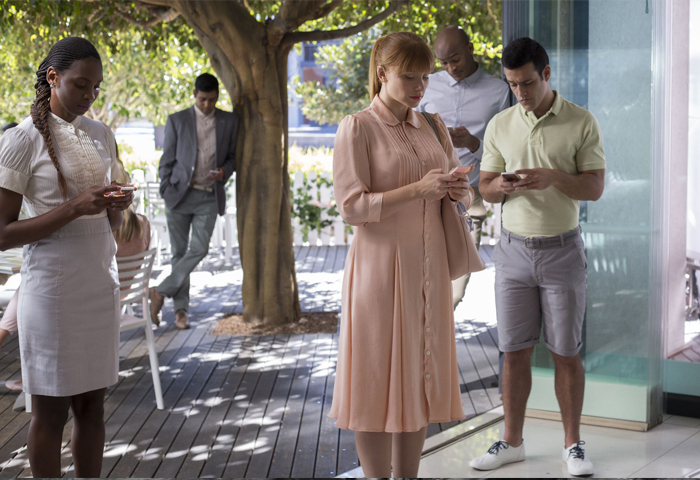And What Do We Have Here?
I remember years ago hearing leadership guru John Maxwell talking about “Putting a ’10′ on everyone’s head.” He was encouraging us to see people as valuable, worthy of our time and attention.
Then yesterday, I watched the first episode of the newly released Black Mirror (season 3) on Netflix. Black Mirror is often described as a modern day Twilight Zone – giving us creepy glimpses of how technology might lead us down a wrong path. This new episode features Lacie—who appears to be a nice, but too sugary-sweet, fake, an annoyingly earnest woman who seems to be doing everything she can to climb the social-standing ladder.
Quickly, you notice Lacie giving and receiving star-ratings on her smart phone with every in-person human interaction. At first, you assume it’s an app that everyone is using… like Facebook or Instagram or Twitter. But then you begin to realize it’s the actual person who is receiving a score: 0 to 5 based on observation or interaction.
Then you discover the power of these ratings. The lease is up on Lacie’s apartment – so she is looking for a new place to stay. When she finds the perfect place, it is just beyond her reach financially… but the agent tells her there is a discount for people with a 4.5 rating. She asks Lacie what her rating is. Lacie is a 4.2, which is respectable, but not quite upper level. The agent encourages Lacie to work on increasing her rating.
Lacie is focused. She’s handing out 5-star ratings left-and-right to everyone she encounters – hoping they will return the favor. But not everyone does, and her score still hoovers below the upper level. Then, when her flight is cancelled and she can’t make it to an important event (with a bunch of 4.5′s and higher), Lacie cracks. She swears at the desk clerk at the airport. Security comes and docks her rating a full point as punishment for her behavior.
Her world is spiraling down along with her score… her worth, value, opportunity, and social standing.
For a more complete review of this Black Mirror episode, check out this article from The Verge.
With Halloween right around the corner, I’ve been thinking about all the little characters who will show up on our doorsteps. We open our doors, and survey the group of trick-or-treaters… “And what do we have here?” we ask. “Oh, I see the Hulk. And a scary monster! Is that a police man? And the princess from Frozen… what’s her name?”
We pay attention. We recognize the costumes and affirm the children. “Beautiful. I love it! Wow.” And then we bless them (give them candy).
This kind of attentiveness, or beholding, is powerful.
We are taking the time to see the image they are projecting, the costume they are wearing, and we accept them—as they are. I believe this shouldn’t happen only on October 31. And I believe it shouldn’t only happen with children looking for candy.
Adults wear costumes too. We project a certain image. We are characters. We long to be seen, to be paid attention to, to be “beheld.”
For some reason, we struggle to accept and bless all the grown-up characters. Some of their “costumes” offend us, bother us, even repulse us. Instead of beholding, we make snap judgments and turn away.
But people need to be “beheld.” We must take the time to see, to really see them. To open the doors of our lives to them, inquiring, “And what do we have here?”
This, by the way, is why claiming to be “colorblind” when it comes to race and ethnicity is unhelpful. While it might sound noble (Oh, I don’t see color… I just see people. There is only one race: the human race…), it is actually dismissive of peoples’ identities. Claiming colorblindness means we aren’t really seeing; we have refused to behold.
The word “behold” appears in the Bible 1,298 times. Author Maggie Ross has suggested it might be one of the most important words in the Bible. Modern translations have chosen more contemporary words to use in the place of behold - words like see or look (the NIV Bible, for example, only uses the actual word behold 6 times). Unfortunately, these words do not carry the same richness of nuance that is in behold.
To behold is to face, regard, consider, observe fully, to look with attention, to survey, to look at purposely, to perceive, apprehend, learn… to know.
So when the Bible says “Behold the Lamb,” words like see just don’t carry enough weight.
Maybe Maggie Ross is right. Perhaps behold is one of the most important words in the Bible.
The first use of the word behold is found in the creation account of Genesis. “So God said: Behold, I have given you every plant yielding seed that is on the surface of the entire earth, and every tree which has fruit yielding seed; it shall be food for you.” —Genesis 1.29
God is speaking to Adam and Eve – instructing them to behold. To take it all in. To face, regard, consider, observe fully, to look with attention, to survey, to look at purposely, to perceive, apprehend, learn… to know. He’s saying, “Take some time to soak this up. Don’t rush. Be attentive. All of this is for you. It’s your food. Read over the menu. Consider everything.”
Have you ever gone to a restaurant that is new to you—one you’ve never been at before? It takes some time to behold the menu.
It’s the same with people. Beholding takes time. We’ll never truly behold when we are in a rush. To behold requires us to slow down.
Snap judgments are just that… they’re snappy. We dismiss people in an instant. We categorize as quickly as possible. But I think we need to slow our roll and take the necessary time to open the doors of our lives to others and say, “And what do we have here?” Let the beholding begin!
If we are unwilling to behold an individual because we don’t like their costume or image they wish to project, we’ll never be granted permission to see who they really are. There will be no sense of community or kinship. And what do we miss out on when we do this? We miss the blessings…
Remember the story of Abraham and Sarah? One day three strangers were standing near Abraham and Sarah’s tent. Abraham welcomed them, invited them in, washed their feet, and provided them with a meal. Abraham could have easily been scared, threatened, or turned-off by these strangers—but he beheld them. And these strangers pronounced a blessing on Abraham and Sarah (the promise of children—the fulfillment of their hopes and dreams). Who were these strangers? Angels? Maybe. Or maybe it was the Holy Trinity, God in three persons. I don’t know, we’d have to ask Abraham—the one who beheld them.
We always treat guests as angels—just in case. —Brother Jeremiah
My friend Randy Dean wrote, “All healthy theology leads us to love humanity; to love ALL humans more deeply, more divinely, more completely, and more toward the miracle of restoration. Any theology, whether intentionally or otherwise, which leads toward a disgust, disregard, dismissal, and detachment from humanity is broken at best, and false at worst. True theology will passionately draw us toward a miraculous faith for the restoration of all people.”
My prayer is that God will give me a holy curiosity and prophetic imagination when it comes to others. Just like we do on Halloween… opening our doors, smiling, inquiring “And what do we have here?” beholding, and blessing.



So good Brian! Your insights are fabulous- you make me better.